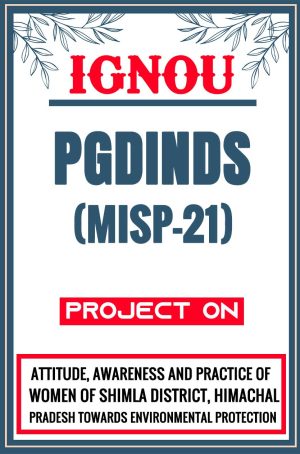Buy IGNOU PGDINDS Project for MISP 021
The IGNOU PGDINDS Project for MISP 021 is the project work for Indira Gandhi National Open University’s Post Graduate Diploma in Industrial Safety, Health, and Environment Management (PGDINDS). MISP 021 is most likely one of the course codes in this program, which focuses on practical aspects of industrial safety, health, and environmental management.
Whatsapp us to get the Personalized (Customized) IGNOU PGDINDS Project Report and Synopsis
Download PDF Link for IGNOU PGDINDS Project (MISP 021)
The IGNOU PGDINDS Project is an essential part of the curriculum, challenging students to apply theoretical knowledge to real-world problems. It usually entails identifying a specific issue concerning industrial safety, undertaking extensive study, and providing efficient remedies. The project’s goal is to help students understand workplace safety regulations, hazard identification, risk assessment, and how to implement safety measures in industrial settings.
Students must demonstrate their ability to independently plan and execute a project, analyze data, and present conclusions in a structured style. The effective completion of this assignment is required for the diploma and has a substantial impact on the student’s overall rating. This hands-on approach is intended to educate graduates for professional careers in industrial safety management, allowing them to effectively contribute to safer working conditions.
What are the key components that should be included in the IGNOU PGDINDS Project report?
When preparing a project report for the IGNOU PGDINDS course, it’s important to include several key components to ensure it meets academic standards. Here’s a breakdown of the essential sections:
- Title Page: This should include the project title, student’s name, enrollment number, course code (MISP 021), and the name of the university.
- Certificate of Authenticity: A statement certifying that the work is original and has not been submitted elsewhere, typically signed by the student and the project guide.
- Acknowledgements: A section where the student can express gratitude to those who assisted in the project, including the project guide, faculty, and any others who contributed.
- Table of Contents: A well-organized index of the sections and subsections in the report, with corresponding page numbers.
- Abstract: A brief summary of the project, highlighting the main objectives, methodology, key findings, and conclusions.
- Introduction: This section provides background information, the significance of the project, and the objectives that the project aims to achieve.
- Literature Review: An overview of existing research and studies related to the project topic, demonstrating the theoretical foundation for the project.
- Research Methodology: A detailed description of the methods used to conduct the research, including data collection techniques, tools, and procedures.
- Data Analysis and Interpretation: Presentation of the data collected during the research, along with analysis and interpretation of the results.
- Findings and Discussion: A section discussing the outcomes of the research, relating them to the objectives and literature reviewed earlier.
- Conclusion and Recommendations: Summarization of the key findings, followed by practical recommendations based on the research outcomes.
- References/Bibliography: A list of all the sources cited in the report, formatted according to academic standards.
- Appendices: Any additional material that supports the report, such as questionnaires, raw data, charts, or photographs, should be included here.
Samples of IGNOU PGDINDS Project topics for MISP 021
- Environmental Degradation In Kangra District Of Himachal Pradesh
- Attitude, Awareness And Practice Of Women Of Shimla District, Himachal Pradesh Towards Environmental Protection
- To Assess The Awareness Among Women About Their Role In Environment Protection With Special Refernece To Hooghly District Of West Bengal
- Menance Of Global Warming: A Socio-Legal Study
- Environmental Degradation In Vijayawada
- Safety management systems: audit tools and reliability of auditing
- How EHS managers can influence environmental excellence within their organization
- Development of a practical and measurable health and safety management system.
How long does it take to complete the IGNOU PGDINDS Project work?
The time required to complete the IGNOU PGDINDS project work can vary depending on several factors, including the complexity of the chosen topic, the availability of resources, and the student’s dedication to the project. However, a general timeline can be outlined:
- Topic Selection and Approval: This initial phase, which involves selecting a project topic, getting approval from a project guide or supervisor, and conducting preliminary research, typically takes about 1-2 months.
- Literature Review and Proposal Development: Conducting a thorough literature review and developing a project proposal can take another 1-2 months, depending on how extensive the research needs to be.
- Data Collection: Gathering primary or secondary data is one of the more time-consuming stages and can take anywhere from 1-3 months. The duration depends on the method of data collection and the availability of information.
- Data Analysis: Analyzing the collected data, which includes organizing, interpreting, and drawing conclusions, usually requires 1-2 months.
- Report Writing: Writing the project report, including drafting, revising, and finalizing, can take 2-3 months. It’s essential to allocate enough time for this stage to ensure the report is well-structured and meets academic standards.
- Submission and Viva Voce (if required): The final stage, which includes submitting the project and preparing for any required presentation or viva voce, may take an additional 1-2 months.
Do you need to conduct primary research, or can you rely on secondary data for your IGNOU PGDINDS Project?
Whether you need to conduct primary research or can rely on secondary data for your IGNOU PGDINDS project depends on the nature of your research topic, objectives, and the specific requirements of your project guide or supervisor. Here’s how you can decide:
Primary Research:
- When to Conduct: Primary research involves collecting new, original data directly from sources such as surveys, interviews, observations, or experiments. It is usually conducted when your research requires specific, up-to-date information that is not available in existing literature.
- Advantages: Provides firsthand data that is directly relevant to your research questions, allowing for more precise and tailored analysis. It can also give you deeper insights into specific industrial safety practices or environmental conditions.
- Challenges: Primary research can be time-consuming and resource-intensive. It may require ethical approvals, especially if it involves human subjects, and you’ll need to design and execute the data collection process carefully.
Secondary Data:
- When to rely on: Secondary research involves using existing data collected by others, such as books, journal articles, reports, government publications, or online databases. It is suitable when your project focuses on analyzing existing trends, comparing past and present data, or reviewing previously conducted studies.
- Advantages: Secondary data is often more accessible, less time-consuming to gather, and can provide a broad context or background for your research. It is particularly useful if the data has already been validated by other researchers.
- Challenges: The data may not be perfectly aligned with your specific research questions, and you may have limited control over the quality and accuracy of the information.
Combination of Both:
- Hybrid Approach: Often, the most robust projects combine both primary and secondary research. You can use secondary data to establish a theoretical foundation or background for your study and then complement it with primary data to address specific gaps or verify hypotheses.
Final Decision:
- Consult Your Guide: It’s essential to discuss your approach with your project guide or supervisor. They can provide guidance on whether primary research is necessary or if secondary data will suffice for your specific project objectives.
What are the steps for re-submission if your IGNOU PGDINDS Project is rejected or needs corrections?
If your IGNOU PGDINDS project is rejected or needs corrections, follow these steps for re-submission:
Review Feedback Thoroughly:
- Carefully read the feedback provided by the evaluator or supervisor. Understand the specific reasons for rejection or the areas that need improvement.
Address Issues:
- Revise Content: Make the necessary changes to your project based on the feedback. This may involve correcting data errors, enhancing analysis, improving writing clarity, or adding missing sections.
- Update Research: If the feedback suggests additional research or data, incorporate these elements into your revised project.
Consult Your Supervisor:
- Seek guidance from your project supervisor or mentor if you have questions about the feedback or need advice on how to make the required changes.
Revise the Project Report:
- Update your project report to address the feedback and corrections. Ensure that the revised report meets all the academic and formatting requirements set by IGNOU.
Prepare a Resubmission:
- Cover Letter: Prepare a cover letter or a summary of changes made, explaining how you have addressed the feedback and revised the project.
- Documentation: Ensure all required documentation, such as the revised report, cover letter, and any additional forms, are properly prepared.
Submit the Revised Project:
- Follow the instructions provided for re-submission. This may involve submitting the revised project report to your project guide or through an online portal as per IGNOU’s guidelines.
- Ensure that you meet any deadlines for re-submission.
Confirm Receipt:
- After submission, confirm that your revised project has been received and is under review. Keep a record of the submission details.
Prepare for Further Evaluation:
- Be prepared for any additional feedback or requirements that might arise. Address any further issues promptly if needed.
Stay in Communication:
- Maintain communication with your project guide or supervisor to stay updated on the status of your resubmission and address any further queries or issues.
Is it mandatory to include a case study in the IGNOU PGDINDS Project?
Including a case study in your IGNOU PGDINDS project is not universally mandatory, but it can be highly beneficial depending on the nature of your research and the requirements of your specific project. Here’s a breakdown to help you determine if a case study is appropriate for your project:
When a Case Study is Beneficial:
- Illustrative Example: A case study can provide a practical illustration of theoretical concepts and methodologies. It allows you to apply and analyze your research within a real-world context, which can enhance the relevance and depth of your project.
- Detailed Analysis: Including a case study can offer detailed insights into specific issues related to industrial safety, health, or environmental management. It helps in showcasing how theoretical knowledge is applied in practice.
- Demonstrates Practical Application: For projects aiming to solve real-world problems or evaluate practical implementations, a case study can demonstrate the practical application of your research findings and recommendations.
When It Might Not Be Necessary:
- Scope and Requirements: If your project is more focused on theoretical research, literature review, or secondary data analysis, a case study may not be essential. Ensure you align with the specific guidelines and requirements set by IGNOU or your project guide.
- Data Availability: If obtaining or analyzing a case study is not feasible due to data constraints or accessibility issues, you can focus on other methods of analysis and data presentation.
- Guidelines: Check the specific guidelines provided by IGNOU or your supervisor. They may outline whether a case study is required or if other forms of analysis are acceptable.
How to Include a Case Study:
- Select a Relevant Case: Choose a case study that is pertinent to your research topic and provides valuable insights related to your study objectives.
- Provide Context: Describe the background, challenges, and context of the case study in detail.
- Analyze and Discuss: Analyze the case study findings and discuss how they relate to your research objectives and theoretical framework.
- Integrate Findings: Use the case study to support your conclusions and recommendations, demonstrating practical implications.
Ready to get your PGDINDS Project Report and Synopsis Sample PDF for MISP 021?
- Call us or WhatsApp us at: 9958947060, 9354637830
- Visit: SHRICHAKRADHAR.COM
-
Sale!

-
Sale!

IGNOU PGDINDS Project (MISP-21) Synopsis/Proposal & Project Report/Dissertation in Hard-Copy (Sample-4)
Original price was: ₹499.00.₹249.00Current price is: ₹249.00. -
Sale!

IGNOU PGDINDS Project (MISP-21) Synopsis/Proposal & Project Report/Dissertation in Hard-Copy (Sample-3)
Original price was: ₹499.00.₹249.00Current price is: ₹249.00. -
Sale!

IGNOU PGDINDS Project (MISP-21) Synopsis/Proposal & Project Report/Dissertation in Hard-Copy (Sample-2)
Original price was: ₹499.00.₹249.00Current price is: ₹249.00. -
Sale!

IGNOU PGDINDS Project (MISP-21) Synopsis/Proposal & Project Report/Dissertation in Hard-Copy (Sample-1)
Original price was: ₹499.00.₹249.00Current price is: ₹249.00.
